Home is where the school is
by Nathaniel Miller
Rebeca Thompson and Gabrielle Tyler live 2,100 miles apart and more than 1,200 miles from the St. Mary’s University School of Law. But that does not stop them from attending classes with the San Antonio-based institution — or from becoming fast friends.
Aaron Chapman lives in Vail, Arizona, and works with a law firm specializing in representing children as they make their way through the adoption system. After work, he goes home to his wife and five kids.
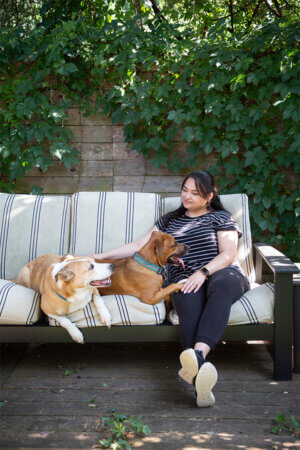
Natalie Kuo, of Austin, was looking for a part-time law program with the flexibility to work without relocating and a university that has a welcoming community.
Scattered across Texas and the United States, these students are part of the inaugural cohort of the School of Law’s Online J.D. program. Announced in Fall 2021, the part-time program was the nation’s first fully online J.D. offering to be accredited by the American Bar Association.
As the first to navigate this four-year program, many of the students were searching for a way to make a law degree more attainable, unaware a fully online program existed until they found St. Mary’s Law.
Some just wanted a part-time program. Others already knew of St. Mary’s through family or word of mouth. Some applied on a whim.
“Among the Texas Capitol crowd, most people either went to the University of Texas or St. Mary’s, and St. Mary’s has a great reputation,” said Katie Carmichael of Austin.
Much like getting into any law program, each student application enters a competitive pool. Of the 797 applications for the inaugural class, only 27 earned a seat — an acceptance rate of 9%. This online cohort is called Section O, a name they embrace proudly.
Already, many students have expressed gratitude for getting the chance to pursue a law degree. Though interactions with each other and faculty are primarily virtual, those in Section O said they have never felt like they’ve been treated differently than on-campus J.D. students.
“I feel like I don’t just attend St. Mary’s University. I feel like I’m a student at St. Mary’s University,” Thompson said. “And I am proud of it.”
Juggling act
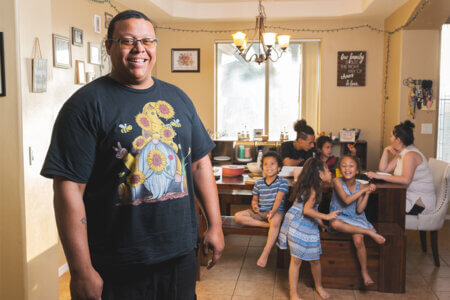
When Aaron Chapman was 18, he already knew he would one day want to adopt children.
As a 9-year-old, he and his brother were officially adopted by their stepfather, and Chapman was always amazed when his stepfather referred to them as his own children.
That compassion encouraged Chapman to consider adoption as well. Now, he and his wife have five children — four adopted.
“They’re mine. It doesn’t matter what their blood says,” Chapman said. “Blood might be thicker than water, but it’s not thicker than love.”
It’s that love of seeing children successfully navigate the foster care system that drove Chapman to law school with the desire to become an attorney who advocates for children’s rights. He used the tribulations of his family’s latest adoption process as extra motivation.
“My primary focus is going to be what’s most important for children and their psychological development versus what’s important for the parents,” Chapman said.
Initially looking to apply to a university in Arizona, Chapman’s research led him to information about the St. Mary’s Online J.D. program while researching schools that offered a part-time or hybrid program. He wondered how different the program would be from his undergraduate studies at Western Governors University, an online, competency-based university.
Aaron Chapman“I was able to pay attention in class, but I was also there to support my son. It’s allowed me the flexibility to be a present father and also a student.”
What he found was an experience similar to any other classroom. Classes are via Zoom but begin promptly. Students can schedule times to meet virtually with professors during office hours or at another convenient time.
Professors post recorded lectures online to help students review lessons or catch up on what they missed, especially if they get caught in traffic on the way home from work or are dealing with a sick family member.
Chapman said there have been times when St. Mary’s Law professors have answered emails late into the evening.
“They know we have children, work and everything else,” he said. “They adjusted schedules to keep answering emails because we’re doing class work at night. We don’t always have other options.”
To teach in the Online J.D. Program, School of Law faculty must be certified through a six-week pedagogy course and complete periodic continuing education.
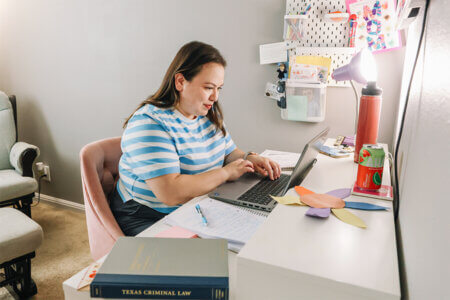
Colin Marks, J.D., Associate Dean for Strategic Partnerships and Innovative Programs and Ernest W. Clemens Professor of Law, said building an online course can be challenging to blend asynchronous and synchronous learning. However, he added, faculty have enjoyed many benefits of teaching online courses.
“After designing the classes, many professors enjoy the smaller classes we have for the online students and the freedom to conduct class from anywhere,” Marks said.
Helena Hernandez Fisher, originally from Laredo, now lives in San Antonio. Though she takes courses online, she enjoys coming to campus when she can. She said juggling a full-time program would not have been possible with her full-time job as a Senior Grant Development Manager at the University of Texas at San Antonio and raising her 5-year-old son.
Hernandez Fisher said faculty have been accommodating of the situations in students’ personal lives. When her son had a karate test to move up in his belt rankings, Hernandez Fisher was sure she would have to miss it because of class. However, her professor told her to go to the event because the lecture would be recorded.
“The professors are experts in their field. They’ve worked for amazing companies. And this is a golden opportunity for us because they’re here to teach us,” Hernandez Fisher said. “These are not C-string coaches. This is the A-Team. And they’re not leaving anything on the table.”
Chapman stressed online classes are not easier because they are virtual. Students must prioritize studying and time management. But flexible schedules have allowed him to be present at events, such as his son’s first track meet.
“I was able to pay attention in class, but I was also there to support my son,” Chapman said. “It’s allowed me the flexibility to be a present father and also a student.”
Friends in virtual places
Rebeca Thompson and Gabrielle Tyler talk as if they’ve been lifelong companions.
Thompson, of Lake Worth, Florida, and Tyler, of Casper, Wyoming, never met before their on-campus orientation at St. Mary’s Law in 2022. Striking up a conversation on the ride to campus from the hotel, the two found shared experiences: husbands who served as youth pastors, motherhood and a return to their education as nontraditional students.
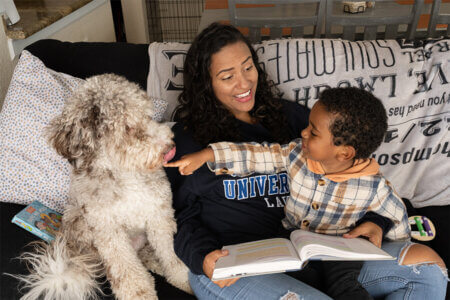
Since that short ride and bonding throughout the first year of classes, the two are planning to get together — along with their husbands — when they come to campus for a professional development weekend during the Fall 2023 semester.
Even during semester breaks, the two make it a point to stay in contact.
“We talk almost every single day,” Tyler said. “During our last break, Rebeca FaceTimed just to say she wanted to see me. It’s hard to make new friends, especially as an adult with children.”
Meeting online for class has been a unique experience. Most on-campus students go to their classroom and sit in the same seat and next to the same people. In comparison, online students mostly see each other on screen.
To build camaraderie, students have found ways to make different connections in place of face-to-face interactions. Many open their virtual rooms for study groups on weekends or will log in to chat before or after class.
The cohort also communicates on GroupMe — a mobile messaging board. Used chiefly for school, the students have also made it a point to make the message board a place for sharing life updates and pictures of children and pets. Students stuck in traffic after work, or someone with a sick family member can leave a message for the group to share with the professor during that evening’s class.
“In my opinion, the online cohort is much closer knit than an in-person cohort because we have this online connection that makes it easier for us to share information,” Thompson said.
Section O also uses the message board to participate in on-campus events when its members cannot all visit in person. For instance, in October 2022, Carmichael led the cohort in collecting donations to purchase candy for the School of Law’s Boo Bash, which provides Halloween candy to local kids. Carmichael said the group had a 100% participation rate and raised just under $1,800.
Sending the money to Grayson Russell, of Castroville, the section purchased enough candy to load his Jeep Grand Cherokee.
“That was a big point of pride for us because it showed everybody that we might not physically be on campus, but we’re here,” Carmichael said.
Connection to campus
During spring semesters, all first-year J.D. students participate in the Linda and Dave Schlueter First-Year Moot Court Competition.
Russell, needing a partner, teamed up with Austin Halvorson, who happens to live in Austin, for the competition despite neither knowing anything about arguing a trial case.
Halvorson is employed with the Gober Group and works with the Texas Legislature and lawmakers. Russell, a space avionics engineer at Southwest Research Institute now works on computers for satellites, but grew up around attorneys. His father graduated from the School of Law in 1986.
When COVID-19 started, Russell realized how much he missed talking with people. Growing up and watching people ask his father for advice, Russell recognized a type of leadership that can make a lasting impact.
“I like that aspect of being the person someone comes to for questions,” Russell said. “It’s why I went into engineering. But being a lawyer is a little bit more down to Earth.”
The duo did not expect to advance far in the moot court competition but found themselves growing more confident with each victory. Before they knew it, they were both on campus for the finals in March — winning first place from judges comprised of the Texas Fourth Court of Appeals justices.
After each round, professors and judges would give the duo pointers on how to improve. The most shocking thing, Halvorson said, was when they first headed into the Law Courtroom and received words of encouragement from on-campus J.D. students in other cohorts.
“They had never seen us before, and they were just really welcoming,” Halvorson said.
Russell added that winning the competition was one of those moments that made law school feel real.
“It gave me the validation that ‘Oh, this is law school,’” Russell said. “That was the final turn for me, saying I can go from engineering to being a lawyer.”
While the teammates found a connection to the campus through competition, some students find their connections through interactions with smaller groups.
Having attended private colleges with small teacher-to-student ratios in the past, Natalie Kuo said she enjoyed building relationships with her instructors and classmates instead of sitting in a large classroom.
Living and working in Austin, Kuo has tried to be part of the larger campus community when she can. In April, she attended the event, Gavels and Gowns, also affectionately known as “law prom,” with a friend in the program and attended the St. Mary’s Law Journal’s banquet. She plans to start writing for the Law Journal this fall.
As a paralegal at Groom Law Firm, Kuo said finding a sense of community can make the challenge of adapting to a new location easier. As someone who was challenged by frequent moves, Kuo said being able to find fun and friends makes challenges feel smaller, even in law school.
Early in her college career, she worked as a DJ in Santa Cruz, California, playing music from the 1990s on a show called All That and a Bag of Chips. Listeners knew her on the air by the name “Status Kuo.”
Though her DJ days are behind her, and she’s not required to participate in extracurricular activities in the online program, Kuo said she wants to do something to continue building her sense of community with the campus by helping grow organizations for online students.
She also said she hopes Section O will continue building stronger personal connections as they progress through the program.
“Forming the camaraderie in the cohort has been essential,” she said. “All the people in Section O sense we’re doing this together. We’re all going to make it across the finish line together.”

